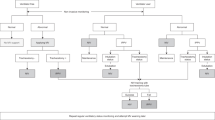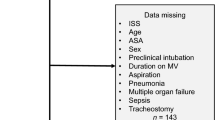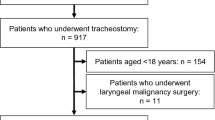Abstract
Study design:
Case series.
Setting:
North West Regional Spinal Injuries Unit, Southport and Formby District General Hospital, UK.
Objectives:
To identify a novel type of tracheal stents for use in patients with high spinal cord injury. Patients with high spinal cord injury (above C4) frequently have significant respiratory impairment and may require long-term access to the trachea for respiratory support. For the most part, tracheostomy tubes are used for this purpose but a tracheal stoma stent can offer a suitable alternative in selected cases and deserves wider recognition.
Methods:
Following completion of a patient questionnaire survey, the authors describe the use of stoma stents in nine patients, five of whom had full-time diaphragm pacing. The stent in these cases is for retention of access for positive pressure ventilation, and for the prevention of obstructive sleep apnoea. This was also the indication in one self-ventilating patient with tetraplegia and sleep apnoea. Two patients with recurrent chest infections, in whom chest physiotherapy was difficult, benefited from the stoma stents. One patient, after ventilator weaning, required a further 4 months of tracheal access on account of episodic hypoventilation and temporarily had a tracheal stent as an inpatient.
Conclusion:
Patients who have had the benefit of tracheal stents report significant improvement in relation to local discomfort, tracheobronchial secretions and vocalization. With suitable training, the stents can be changed and cleaned easily in the home setting.
Similar content being viewed by others
Log in or create a free account to read this content
Gain free access to this article, as well as selected content from this journal and more on nature.com
or
References
Soni BM . Use of Phrenic nerve stimulator in high ventilator dependent spinal cord injury. Conference proceedings; Network for rehabilitation using functional electrical stimulation for therapy and function restoration 2002. http://fesnet.eng.gla.ac.uk/.
Cooper JD, Pearson FG, Patterson TR, Ginsberg RJ, Goldberg M, Waters P . Use of silicone stents in the management of airway problems. Ann Thorac Surg 1989; 47: 371–378.
Hung-Chang L, Kuo-Sheng L, Charng-Jer H, Ching-Ron C, Wen-Hu H, Ming-Hsiung H . Silicone T-Tube for complex laryngotracheal problems. Eur J Cardiothorac Surg 2002; 21: 326–330.
Jer-Huang J . Use of the silicone T-tube to treat tracheal stenosis or tracheal injury. Ann Thorac Cardiovasc Surg 2001; 7: 192–196.
Author information
Authors and Affiliations
Corresponding author
Appendix 1
Appendix 1
Patients' view of the stents

Rights and permissions
About this article
Cite this article
Hall, A., Watt, J. The use of tracheal stoma stents in high spinal cord injury: a patient-friendly alternative to long-term tracheostomy tubes. Spinal Cord 46, 753–755 (2008). https://doi.org/10.1038/sc.2008.18
Received:
Revised:
Accepted:
Published:
Issue date:
DOI: https://doi.org/10.1038/sc.2008.18
Keywords
This article is cited by
-
Diaphragm Pacers in Pediatric Patients with Cervical Spinal Cord Injury: a Review and Implications for Inpatient Rehabilitation
Current Physical Medicine and Rehabilitation Reports (2018)



